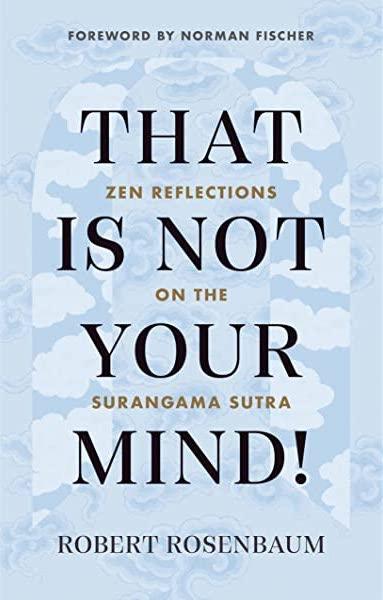As I prepared to delve into this exploration of the Mahayana Surangama Sutra, which is particularly influential in Chan Buddhism and one of the most significant and revered sutras for all Buddhists seeking enlightenment, I wondered to myself: how does one use language to describe the ineffable?
As someone who thoroughly enjoys learning about the inner workings of the human brain, and relishes the long, hard-to-pronounce technical and chemical terms used in component-parts breakdowns and in the ensuing epistemological implications—and as someone who is also excited by the fundamental nature of reality as viewed by quantum physicists and how it marries with spiritual practice—I was more than looking forward to reading this book by Robert Rosenbaum, PhD, which draws on his decades as a neuropsychologist, a psychotherapist, a mind-body medicine educator, and a Zen practitioner.
And while this volume is not replete with a quagmire of intellectual or technical jargon, it is probably all the better for it as it makes for far more accessible and relatable reading. Plus, I was actually able to pronounce any technical terms that were used, which is always nice. What this book did succeed in doing is reminding me to get out of my own head. This is not to say that this book is overly simplified in spelling out its message, either; it will still bend your mind (“not your mind”).
Rosenbaum is transparent in volunteering that this book is an overview of the Surangama Sutra rather than a deep dive. And the author does a lovely job of opening the door to the teachings, the conversations on interpretation, and the penetrating questions asked by Shakyamuni Buddha more than two-and-half millennia ago. Rosenbaum takes us into the realms of modern science and psychology while also giving us some real grassroots, pragmatic, and practical advice that would be right at home in any modern phenomenological, philosophical debate or therapy session.
I am left asking things like: Why do we do the things we do? What is our modus operandi? What is the nature of mind? What is the origin of sensation? What is our subjective, existential axis mundi? And do we really think that any of it can exist at all? Why are we drawn to meditation or to any religious or spiritual path? What is our core, honest motivation? Do we wear a mala for fashion? Are we a walking corruption of projected virtue? Are we spiritually sanctimonious or self-effacing, falsely humble or all rainbows and unicorns? Is our earnest quest merely a hopeful search for “something” at the end of it all? Is it an escape? Is it “Truth?” Is it self-awareness? The questions dig deeper and deeper until we are faced with ultimate reality. Do we practice mindfulness meditation first and hope that the rest falls into place? Or do we follow the Noble Eightfold Path and then meditate?
Human beings don’t seem to have changed much over the thousands of years since the Buddha shared his wisdom. We seek happiness and we seek to avoid suffering. We run the gauntlet of emotions. We may look with “evolved eyes” at the prevailing social attitudes and mores of the past and argue that some teachings have not time-traveled well. However, if we reflect further, it’s clear that some contemporary societies are just as brutal, ignorant, biased, and misogynistic as ever. Yet contemporary science of the past 200 years echoes one of the most fundamental insights from thousands of years ago: namely that nothing inherently exists. Modernity appears to be playing catch-up with the past.
With the past in mind, Rosenbaum, while giving us some background on the sutra’s origins, is far more concerned with sharing the text’s practical implications in the modern world. And nothing says modern like sex. Nothing says timeless like sex. And that is the springboard for this sutra. Of course, I’m not reviewing the sutra itself, but this book about it, within the context of the sutra.
As a first-time introduction, it might tell of the poor “victim” guy, who can’t control himself and falls for yet another seductive, morally corrupting woman, against whose charms—her magical ways—he is powerless, until saved in the nick of time by the wise one . . . phew! Bad woman for whom enlightenment is impossible! Misogynistic, eye-rolling prose in which the female is “lesser” and amoral, in which sex and relationships are the antitheses of the spiritual path.* Or, worse still, we may read it and accept it as a truism.
Yet as we continue deeper, Rosenbaum makes clear that attitudes toward gender, sex, sensuality, and the power of today’s Buddhism still need much work. The sutra’s point, while filtered through the contextual veil of an ancient culture, is actually that, due to the non-inherent nature of all phenomena, including the most primordial passions of engagement, it is purely an illusory allure that can tempt any of us off our rightful chosen path (even if that temptation is the “clickbait” of a smartphone ping when we’ve promised ourselves that we will focus on writing a book review). Oh, and spoiler alert for those who are unfamiliar with the Surangama Sutra: the woman not only becomes a disciple but a fully fledged arhat.
One of Rosenbaum’s gifts in this book is in bringing a contemporary and relatable translation to a sutra that, to some, may seem overly obscure, dated, or complicated, or so body-based and ego-centric. As an experienced psychotherapist, Rosenbaum has skillfully created a space in which to feel safe while holding the mirror square to our face.
As a neuropsychologist, I’m bemused by how meditators are willing to acknowledge that thoughts are often misleading but continue to believe that sense-perceptions are “really real.” Our sense-perceptions, like our thoughts, are self-centered.
(Rosenbaum, 74)
The book is replete with Rosenbaum’s pithy anecdotes, both professional and private. In this way, we are carried between past and present, each time scratching away at the metaphorical jewel-obscuring dirt. Rosenbaum dances with metaphors aplenty as a point of fact, which is a communication style I both enjoy and employ myself.
Rosenbaum also includes some useful Buddhist terms and potential accompanying practices, which helps to make this book a gem for beginners and anyone new to this sutra or to Buddhist practices in general. Or even quantum physics, come to that (although he is very gentle with us here as it’s a topic that can melt the brains of the best of us). Rosenbaum also gives us some lovely, gentle insights into neurology—enough to remind me of the likes of the famed neuroscientists V. S. Ramachandran and Joe Dispenza, whose work I deeply admire—alongside deeper dives into neuropsychology and even cymatics.
In this wonderful book, Rosenbaum invites us to think deeper and wider, and to engage in the conversations that the sutra inspires. And he brings these worlds together beautifully, inviting us to gaze into the past and into the present, to navigate dichotomies, and to focus and dissolve with the mind, and the no-mind.
“Please treasure yourselves.”
(The Buddha)
* Certain tantric practices aside.
References
Rosenbaum, Robert. 2022. That Is Not Your Mind! Zen Reflections on the Surangama Sutra. Boulder, CO: Shambhala Publications.
Related features from BDG
Book Review: Talking Zen by Alan Watts
Book Review: Zen Master Tales: Stories from the Lives of Taigu, Sengai, Hakuin and Ryokan
Book Review: How We Live Is How We Die by Pema Chödrön














